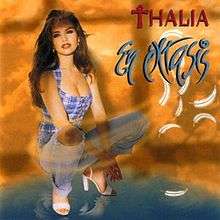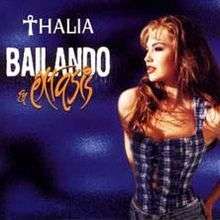En éxtasis
| En éxtasis | ||||
|---|---|---|---|---|
 | ||||
| Studio album by Thalía | ||||
| Released | 12 September 1995 | |||
| Recorded | 1994–1995 | |||
| Genre | ||||
| Length | 57:53 | |||
| Label | EMI Latin | |||
| Producer |
Oscar Lopez Emilio Estefan, Jr. Kike Santander Mario Ruiz | |||
| Thalía chronology | ||||
| ||||
| Alternative covers | ||||
 Bailando en éxtasis | ||||
| Singles from En éxtasis | ||||
| ||||
| Professional ratings | |
|---|---|
| Review scores | |
| Source | Rating |
| 'StarPulse | |
| Allmusic | |
En éxtasis (English: "In ecstasy") is the fourth studio album by Mexican singer Thalía. The album was released in 1995 and soon became a huge success in Latin America and other countries. This is the first album Thalía recorded on the company EMI Music. This is also her first international release.
"En éxtasis" produced seven hit singles, received several certifications and consolidated her career. The lead single "Piel Morena" was a huge hit around the world, peaking at number one in over 25 countries, while the single "Maria la del Barrio" was a popularity phenom. The album was nominated for Pop Album of the Year at the Lo Nuestro Awards of 1996.[3]
Production and content
"En Éxtasis" was produced by the Mexican producer Oscar López, except for the songs "Piel Morena" and "Me Faltas Tú", which were produced by Emilio Estefan and Kike Santander.
The album includes several cover songs:
- "Gracias a Dios", originally by the Mexican singer Juan Gabriel.
- "Me Erotizas"("You turn me on"), originally performed by the French singer Herbert Léonard, under the name "Sur des musiques érotiques" ("About erotic musics") on the 1987 album "Laissez-nous rêver" ("Let us dream"). Thalia wrote a new Spanish lyric for the song.
- "Fantasía" ("Fantasy"), by Gabriela Anders
- "Te Quiero Tanto" ("I love you so much"), originally by Eddie Sierra on the 1990 album "Está todo bien" ("Everything is alright"). The lyric of the song had to undergo some changes, not only because it was a woman who was performing it this time, but also because its author had used some expressions which are typical of the Argentinean Spanish (such as "vos", a way of addressing someone), and referred expressly to Buenos Aires (one of the original verses goes: "estoy atrapado entre la luna y Buenos Aires" -"I am trapped between the moon and Buenos Aires"-; which Thalía changed to "estoy atrapada entre la luna y los mares" -"I am trapped between the moon and the sea"-).
In Argentina, "Gracias a Dios" was the soundtrack of the soap-opera "María la del Barrio" ("Mary from the block"), starring Thalía, instead of the song with which it was originally released in México (and which also became a hit).
The number of songs included in "En Éxtasis" was not the same in all the countries where it was released. This is due to the fact that, at the same time the album was being released, Thalía's most successful soap-opera, "María, la del Barrio" ("Mary from the Block"), was being broadcast in all Latin America . Even though this contributed to expand Thalía's popularity throughout the Continent, it also made different people enjoy different songs. For example, the Brazilian version of the album features, as bonus tracks, a remixed version of the songs "Amándote" ("Loving you") and "Gracias a Dios" ("Thanks to God"), and the soundtrack from "María la del Barrio" ("Mary from the block"). However, this version does not include the song "Juana". On the other hand, the Argentinean version of the album features, as a bonus track, only a remixed version of "Piel Morena".
"En éxastis" became such a success worldwide that EMI decided to release a special edition of it, named "Bailando en Éxtasis" ("Dancing in Ecstasy"), which contained only remixed versions of the most popular songs featured in the original album, plus a karaoke version of "Piel morena". This was a limited edition and was not available in many Latin-American countries (for instance, in Argentina).
Singles
- Piel Morena
- Amandote: released as the second single of the album. The music video was shot in Miami and directed by Meter Begman. It shows Thalia wearing a pink bikini in a famous beach, playing volleyball and skating around the city. Then she goes into a retro style and dance with her friends. There is a cameo appearance of the Spanish singer Julio Iglesias. It was the second time that they collaborated appearing in a music video.
- Maria la del Barrio
- Quiero hacerte el amor: released as the fourth single of the album. Thalia performed the song during her TV appearances and it was in the set-list for her concerts that time. An english version was released years later in her album Nandito Ako.
- Gracias a Dios
- Me faltas tú: Written by Aureo Baqueiro and Thalía, the song is about a person missing someone. Thalia made many performances of the song in TV shows and concerts. She gave a memorable live performance to the song featuring Julio Iglesias, which was considered an iconic act by the latin community.
- Lágrimas: Written by Aureo Baqueiro and Thalía, released as the seventh and final single of En éxtasis. It is also the last song written by Thalia about body fluids, after "Saliva", "Sudor" and "Sangre". She sang part of the song in a music video wearing a green dress in 1994, as a part of her special in "Chabeli", a Mexican TV program. Thalia performed it a few times and also sang it in her future soap opera Rosalinda.
Commercial performance
"En Éxtasis" gave Thalía multiple gold and platinum records and made her win several prizes worldwide. Besides, this album paved the way to the extremely successful international career on which she was going to embark in the years to come. As of July 1996, the album sold a half million copies worldwide.[4]
She received a lot of certifications in an only day in 1997, during the inauguration of EMI's Miami office.[5] It was a huge event, with over 15 different TV channels and music directors from several countries.[5]
Track listing
| No. | Title | Writer(s) | Length |
|---|---|---|---|
| 1. | "Piel Morena" | Kike Santander | 4:42 |
| 2. | "Juana" | Myra Stella Turner | 2:49 |
| 3. | "Quiero hacerte el amor" | Daniel García, Mario Schajris | 3:59 |
| 4. | "Amándote" | A. B. Quintanilla III, Ricky Vela | 3:48 |
| 5. | "Llévame Contigo" | Adrian Posse, Rolando Hernández | 3:41 |
| 6. | "Me Erotizas" | Vline Buggy, Julien Lepers, Thalía | 4:59 |
| 7. | "Gracias a Dios" | Juan Gabriel | 4:01 |
| 8. | "Lágrimas" | Aureo Baqueiro, Thalía | 4:29 |
| 9. | "Te Quiero Tanto" | Eddie Sierra | 3:11 |
| 10. | "Te Dejé la Puerta Abierta" | Adrian Posee, B.B. Muñoz | 3:08 |
| 11. | "Fantasía" | Gabriela Anders | 4:17 |
| 12. | "Me Faltas Tú" | Kike Santander | 5:10 |
| 13. | "Piel Morena" (Pablo Flores Remix) | Kike Santander | 6:43 |
| Bonus Tracks | |||
|---|---|---|---|
| No. | Title | Writer(s) | Length |
| 14. | "María la del Barrio" | Viviana Pímstein, Paco Navarrete | 3:53 |
| Remastered Edition Bonus Tracks | |||
|---|---|---|---|
| No. | Title | Writer(s) | Length |
| 15. | "Piel Morena" (Hitmakers Remix) | Kike Santander | 5:14 |
| 16. | "Piel Morena" (Emilio Mix) | Kike Santander | 4:43 |
| 17. | "Piel Morena" (Instrumental) | Kike Santander | 4:43 |
| Bailando En Éxtasis | |||
|---|---|---|---|
| No. | Title | Writer(s) | Length |
| 1. | "Piel Morena" (Club Remix) | Kike Santander | 6:43 |
| 2. | "Amándote" (House Latino Mix) | A. B. Quintanilla III, Ricky Vela | 7:53 |
| 3. | "Gracias A Dios" (Midi's Club Mix) | Juan Gabriel | 4:00 |
| 4. | "María la del Barrio" (Album Version) | Viviana Pímstein, Paco Navarrete | 3:53 |
| 5. | "Juana" (Album Version) | Myra Stella Turner | 2:49 |
| 6. | "Amándote" (Radio Mix) | A. B. Quintanilla III, Ricky Vela | 3:33 |
| 7. | "Gracias a Dios" (Midi's Radio Mix) | Juan Gabriel | 4:00 |
| 8. | "Amándote" (TapatiMix) | A. B. Quintanilla III, Ricky Vela | 4:41 |
| 9. | "Gracias a Dios" (70's Midi Club Mix) | Juan Gabriel | 6:11 |
Charts and certifications
Weekly charts
|
Certifications and sales
| |||||||||||||||||||||||||||||||||||||
Credits
|
Production
|
See also
References
- ↑ Jason Birchmeier, Rovi. "En Extasis Album Review, Songs, Ratings". starpulse.com. Retrieved 9 August 2011.
- ↑ "allmusic ((( En Extasis > Overview )))". www.allmusic.com. Retrieved 2010-01-23.
- ↑ "Univision Announces The Nominees For Spanish-Language Music's Highest Honors: Premio Lo Nuestro A La Musica Latina". PR Newswire. Free Online Library. 1996-03-27. Retrieved 2013-06-11.
- ↑ Baduel, Graciela (1996-07-11). "Es la protagonista de "Marimar", la tira mexicana que arrasa con los rátings". Clarin. Clarín Group. Archived from the original on February 5, 2016. Retrieved February 5, 2016.
- 1 2 3 4 "Thalía volvío a ser reina en Miami: Oro y Platino para una gran estrella". 8 September 1997. Archived from the original on 23 May 2000. Retrieved February 25, 2016.
- ↑ Peak positions for Greece:
- En Extasis:"Greek Charts (Από 23/04/2000 έως 30/04/2000)". MAD TV (Greece). Archived from the original on 28 December 2007. Retrieved 2 February 2016.
- ↑ "Top 40 album DVD és válogatáslemez-lista – 2001. 16. hét" (in Hungarian). MAHASZ. Retrieved 8 October 2016.
- ↑ "Thalia – Chart history" Billboard Top Latin Albums for Thalia. Retrieved June 12, 2016.
- ↑ "Thalia – Chart history" Billboard Latin Pop Albums for Thalia. Retrieved June 12, 2016.
- ↑ "Thalía un fenómeno de popularidad". El Siglo de Torreón (in Spanish). August 19, 1996. Archived from the original on February 9, 2016. Retrieved February 9, 2016.
- ↑ "Brazilian album certifications – Thalia – En extasis" (in Portuguese). Associação Brasileira dos Produtores de Discos.
- 1 2 3 4 "Thalia Latin America's Reigning Music Queen". Billboard Magazine. 109 (48): 33. November 29, 1997.
- ↑ "Certificaciones – Thalia" (in Spanish). Asociación Mexicana de Productores de Fonogramas y Videogramas.
- ↑ "American album certifications – Thalia – En extasis". Recording Industry Association of America. If necessary, click Advanced, then click Format, then select Album, then click Type, then select Latin, then click SEARCH